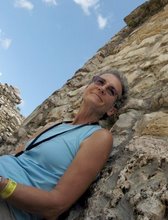 I fly back to Austin tomorrow, but I will continue to post my work about Palenque to this blog. The research that Anabella and I are doing this summer is not just about tourism, but about the general long term sustainability of the site. Quite a broad subject, you’re thinking? Yes, but we are hoping to at least present some useful suggestions and conclusions that will include other things beside tourism -- for instance, the problem of the destruction of ancient buildings by rain water (to be addressed in the next blog). According to Rudy Larios (2005) water is a “number one enemy” of these ancient limestone structures (see http://www.famsi.org/reports/99026/section16.htm for his report called “Architectural Restoration Criteria in the Maya Area”).
I fly back to Austin tomorrow, but I will continue to post my work about Palenque to this blog. The research that Anabella and I are doing this summer is not just about tourism, but about the general long term sustainability of the site. Quite a broad subject, you’re thinking? Yes, but we are hoping to at least present some useful suggestions and conclusions that will include other things beside tourism -- for instance, the problem of the destruction of ancient buildings by rain water (to be addressed in the next blog). According to Rudy Larios (2005) water is a “number one enemy” of these ancient limestone structures (see http://www.famsi.org/reports/99026/section16.htm for his report called “Architectural Restoration Criteria in the Maya Area”).  But now, lets talk about water drainage across the landscape. Ed Barnhart and his survey crew were able to map creeks and streams of the site and you can see them on this map. In addition, they also mapped the springs. Rest assured that a location with over 50 natural springs and sitting in the path of the warm trade winds, has serious water management issues. For the time being, I am classifying the drainage facilities into four categories with two sub classes each, but there is only room here to show you a few examples.
But now, lets talk about water drainage across the landscape. Ed Barnhart and his survey crew were able to map creeks and streams of the site and you can see them on this map. In addition, they also mapped the springs. Rest assured that a location with over 50 natural springs and sitting in the path of the warm trade winds, has serious water management issues. For the time being, I am classifying the drainage facilities into four categories with two sub classes each, but there is only room here to show you a few examples. One type is that of the closed drain, both ancient and modern. Here is a picture of a closed modern drain that was created in conjunction with the walkway. I don’t know how they are able to clean it out, since it is L-shaped.
One type is that of the closed drain, both ancient and modern. Here is a picture of a closed modern drain that was created in conjunction with the walkway. I don’t know how they are able to clean it out, since it is L-shaped. Here is a map of an ancient aqueduct. As you can see from the blue color of the water, it is both open and closed.
Here is a map of an ancient aqueduct. As you can see from the blue color of the water, it is both open and closed. Another type drain is the modern open drain. The red displays the path of this modern structure.
Another type drain is the modern open drain. The red displays the path of this modern structure. When the drains don't work properly, they deteriorate the walkways and can even wash away concrete if the velocity down this hill is strong enough. In the next time I want to show you some pictures of what is happening to the ancient structures when it rains and what a difficult job it is to prevent the limestone building material from melting away. Thus they will become- one day in the future - only memories of what once was fabulous architecture.
When the drains don't work properly, they deteriorate the walkways and can even wash away concrete if the velocity down this hill is strong enough. In the next time I want to show you some pictures of what is happening to the ancient structures when it rains and what a difficult job it is to prevent the limestone building material from melting away. Thus they will become- one day in the future - only memories of what once was fabulous architecture.















































